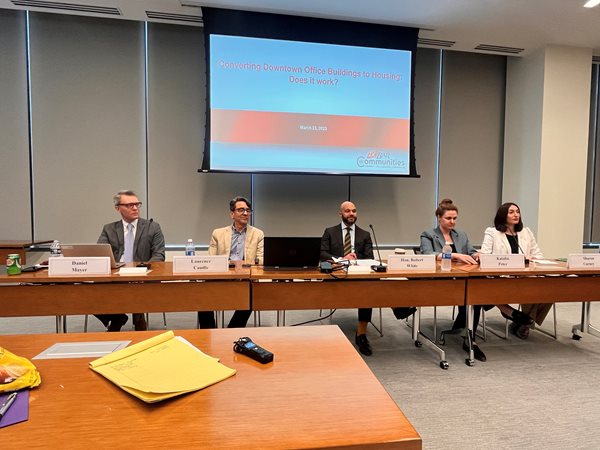Issues & Trends
Considerations for Converting Office Space to Housing in the District
April 11, 2023

From left to right: Moderator Daniel Mayer, Laurence Caudle, D.C. Councilmember Robert White, Katalin Peter, and Sharon Carney.
Approximately 20 million square feet of the District of Columbia’s more than 75 million square feet of office space downtown is vacant, the city’s highest vacancy rate in the last 30 years.
Washington, D.C., is “not going back to [how] it was in 2019,” said at-large D.C. Councilmember Robert White at a D.C. Bar Communities event in late March exploring the issue of converting downtown office buildings to residential housing, given the rise of telework in the three years since the COVID-19 pandemic.
White said the downtown area was already in decline even before the pandemic. “By the time I got to the Council, our commercial vacancy rates were … historically at 11, 12, 13 percent,” he said. “In my view, the trend was companies moving away from these big, expansive offices. The federal government and the private sector were increasingly looking at telework options, and people were starting to really shop online. I saw that trajectory [already] pushing us to think differently about downtown D.C.”
Sharon Carney, chief of staff at the Office of the Deputy Mayor for Planning and Economic Development (DMPED), said the current downtown vacancy rate is almost double the 2018 figure of 12 percent, with many commercial buildings sitting underutilized. “Stakes are high,” said Carney.
In early January 2023, D.C. Mayor Muriel Bowser and DMPED announced the city’s Comeback Plan, which, among its significant goals, includes adding 15,000 residents to downtown D.C. over the next five years through the creation of seven million square feet of residential units.
Such efforts could offset the projected loss of nearly half-billion in property tax revenue during the next three years, according to Carney. “We need to act now to address this before some of these empty buildings become empty blocks,” Carney said.
Carney added that the city’s Housing in Downtown Tax Abatement program is an important step in this direction, offering commercial property owners 20-year tax abatements when they convert at least 15 percent of their properties into affordable housing.
“I think the next chapter downtown includes a lot of residential,” agreed White. “I think it includes opportunities to create that 24/7 market, and bringing in revenue that we’re not seeing right [now] will bring downtown to life.”
However, converting abandoned or vacant retail and office spaces into residential homes involves zoning code reevaluations, intricate internal architectural restructuring, and financial considerations.
Laurence Caudle, director of housing at the Hickok Cole design firm, touched upon many of the technical considerations involved in converting commercial spaces into residential homes. Each building has its own structural quirks, Caudle pointed out, and in researching potential buildings to be transformed, his architectural firm found that “maybe 3 out of 10 office buildings really make sense.”
“When we’re talking about office buildings, we are looking at how to transform some of these difficult assets, which have really aged out in terms of the use and purpose and desires,” Caudle said.
From a financial standpoint, only 1 of 10 commercial buildings could work for conversion, said Katalin Peter, vice president of government affairs for the Apartment & Office Building Association of Metropolitan Washington. “Even if [you’re] converting [from commercial] to residential, you're still paying the commercial tax rate during construction,” Peter said. “When you're pulling a construction permit, you're still paying the recreation tax twice, based on the current tax code. So, these things, before you even try to figure out creatively how you could possibly do them, are pretty difficult [financial costs] to swallow.”
Peter reminded attendees that affordable housing is another key component to Mayor Bowser’s Comeback Plan. “If you're familiar with the numbers on square footage, we're looking at [charging] $4 a square foot,” which translates to approximately $3,000 for a one-bedroom unit. “That’s pretty high,” Peter said.
Peter said developers also need to consider amenities that people come to expect in residential areas, such as grocery stores, drug stores, and other businesses. “People have to want to live in downtown D.C.,” she said. “People are going to be looking for some of those basic amenities, not just stores where you can buy a suit or some fancy coffee shop. It needs to be something for your everyday Washingtonian.”
Faced with numerous uncertainties, White said the D.C. government can only look so far ahead. “But if we create the right ecosystem, changes will follow,” he said. “As the ecosystem shifts, there will be other demands [for certain amenities], and the market is going to respond to those demands in some ways that we just can’t predict. But if we believe that the goal and vision [to convert offices to residential space] are viable, we have to create the right conditions, step out on faith, and try to navigate as best as we can.”


